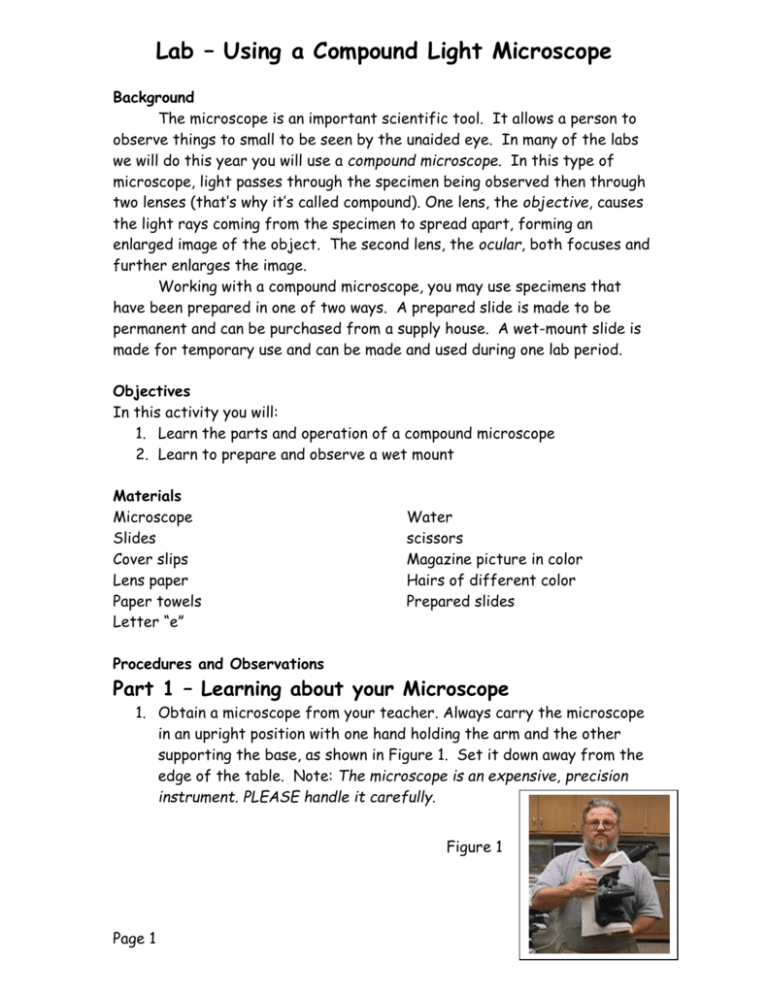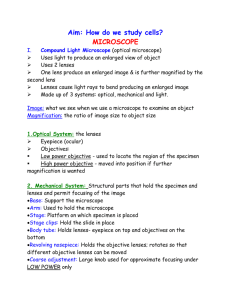Lab – Using a Compound Microscope
advertisement

Lab – Using a Compound Light Microscope Background The microscope is an important scientific tool. It allows a person to observe things to small to be seen by the unaided eye. In many of the labs we will do this year you will use a compound microscope. In this type of microscope, light passes through the specimen being observed then through two lenses (that’s why it’s called compound). One lens, the objective, causes the light rays coming from the specimen to spread apart, forming an enlarged image of the object. The second lens, the ocular, both focuses and further enlarges the image. Working with a compound microscope, you may use specimens that have been prepared in one of two ways. A prepared slide is made to be permanent and can be purchased from a supply house. A wet-mount slide is made for temporary use and can be made and used during one lab period. Objectives In this activity you will: 1. Learn the parts and operation of a compound microscope 2. Learn to prepare and observe a wet mount Materials Microscope Slides Cover slips Lens paper Paper towels Letter “e” Water scissors Magazine picture in color Hairs of different color Prepared slides Procedures and Observations Part 1 – Learning about your Microscope 1. Obtain a microscope from your teacher. Always carry the microscope in an upright position with one hand holding the arm and the other supporting the base, as shown in Figure 1. Set it down away from the edge of the table. Note: The microscope is an expensive, precision instrument. PLEASE handle it carefully. Figure 1 Page 1 Parts of the Microscope 2. Compare your microscope with Figure 2. Label each part of the microscope. Page 2 12 Amount of Light 3. Find the diaphragm. Adjust it to the largest opening so that the most light enters the microscope. Do this by looking under the stage and aligning the largest opening of the diaphragm with the opening in the stage. Then look through the ocular and rotate the nose piece from one objective to another to determine which objective has the brightest field of view. a. What does the diaphragm control? _____________________ b. Under what objective is the Field of view brightest? _______ Magnification 4. Turn the nosepiece so that the low power objective is clicked into place. The low power objective is the shortest objective. a. Look at the number followed by an “X” or by a “/”on the side of each objective. This number is the magnifying power. The “X” stands for “times”. Thus, the number tells you how many times an object is magnified by this lens. i. Magnification of each objective: 1. Low power __________________ 2. Medium power _______________ 3. High power _________________ 5. The ocular lens also has a magnifying power. So not only is it used to look through to view a specimen, it also enlarges the image. a. Examine the ocular lens. What is the magnifying power? __________ To calculate the total magnification a specimen is viewed under use the following formula: Ocular magnification x Objective magnification = Total magnification (The total magnification is always given next to the image.) Show your work: b. Calculate total magnification when low power objective is used: _______________________________________________ c. Calculate total magnification when medium power objective is used: _______________________________________________ d. Calculate total magnification when high power objective is used: _______________________________________________ Page 3 Part 2 – Preparing and Examining a Wet Mount 1. Cut a small letter “e” from the paper provided by your teacher. 2. Place the square in the middle of a clean slide in proper “reading” position. With a dropper, put 1 drop of water on the square. 3. Cover the mount with a clean cover slip. a. Hold the cover slip at a 45o angle to the slide and drag it across the slide toward the water. As the water touches the cover slip, it will spread along the edge. Gently lower the cover slip onto the specimen. b. A good wet mount is free of bubbles. If bubbles are present they can interfere with the viewing of the specimen. 4. If bubbles are present, take off the cover slip and absorb the water with a paper towel, then repeat steps 2 and 3. Procedure for Focusing the Microscope 1. Turn on the light source 2. Make sure the lowest power objective is in place (the shortest one). 3. Place the slide on the stage so that the specimen you are viewing is facing you and under the objective and over the hole in the stage that allows light to come through. Secure the slide with the stage clips. 4. Looking from the side of the microscope, carefully raise the stage by turning the course adjustment knob until the low power objective is almost touching the slide. DO NOT LET IT TOUCH THE SLIDE! 5. Look through the eyepiece (ocular) and adjust the diaphragm if it is too dark or too bright. 6. While looking through the eyepiece, slowly turn the coarse adjustment so that the low power objective moves away from the slide until you see the object. You may have to slowly move the slide around to find the specimen if you don’t see anything after moving the objective. 7. When you find the specimen, turn the fine adjustment until the specimen is clearly focused. 8. Very gently move the slide until the object is exactly centered. 9. Without touching the slide or the adjustment knobs, turn the nosepiece so that the medium power objective is in place. Focus using fine adjustment. 10. Repeat step 9 with high power objective. 11. At this point, DO NOT TOUCH THE COURSE ADJUSTMENT KNOB! Focus the image using only the fine adjustment knob! (You can damage the slide and/or the objective lens if you use the course adjustment!) Page 4 Manipulating the slide Place slide on the stage in “reading position” e 1. Once you have the image focused under low power, move the slide to your left. Which way does the image move when viewed through the ocular? __________________ 2. Which way does the image move when you move it to your right? _________ Changes in Image In the space provided, draw the letter “e” exactly as you see it through the ocular under low power. What three things are different between the specimen on your stage and the image you see through the ocular. 1. ____________________________________________ 2. ____________________________________________ 3. ____________________________________________ Field of view - the amount of area of a slide that can be seen when viewed through the ocular. 1. Now view the letter “e” under all three objectives, starting with low power, and draw each image exactly as you see it in the space below. Remember to follow the focusing procedures previously learned. Refer back to those procedures if needed. Record the total magnification on line next with “X”. Low Power ______X (Total Magnification) Medium Power ______X High Power ______X 2. What is the definition of field of view? __________________________________________________________ 3. What happens to the size of the field of view as you increase magnification? __________________________________________________________ 4. Under which objective is the field of view the largest? _________________ Page 5 Resolving Power Resolving power is the ability to distinguish between two separate points that are very close together. 1. Make a wet mount using a square of solid color from a colored picture. a. What color is your square? ___________________________ 2. Observe the slide under low, medium, and high powers. a. How is the color distributed? _________________________ b. What colors do you see? _____________________________ c. Which resolving power is greater, the human eye’s or the microscope’s? _____________________________________ d. How do you know? _______________________________________________ _______________________________________________ Depth of Field When viewing a specimen it is important to remember that it is not flat. There is depth (thickness) to it, and the whole specimen will not be in one plane (on one level). The microscope can only focus on one level at a time. Therefore, you will only be able to focus on one part of the specimen at a time. 1. Prepare a wet mount using two hairs of different colors. Cross them on the slide making an “X” directly in the center of the slide. 2. View the slide under low power. Focus directly on the point where the hairs cross. Make certain that the “X” of the hairs is directly in the center of your field of view. a. Are both hairs in focus under low power? ________________ 3. Switch to medium power, focus making certain that the “X” of the hairs is directly in the center of your field of view. 4. Switch to high power. Once again focus making certain that the “X” of the hairs is directly in the center of your field of view. a. Are both hairs in focus under high power? ________________ b. Why not? _______________________________________________ _______________________________________________ Draw the hairs as viewed under high power, in color, in the space provided. Page 6 Analysis and Interpretation 1. For each part of the microscope listed below, write the complete function(s). a. Ocular - _______________________________________________ b. Coarse adjustment – ______________________________________ c. Fine adjustment - ________________________________________ d. Nosepiece – ____________________________________________ e. Objectives – ___________________________________________ f. Stage – _______________________________________________ g. Stage clips – ___________________________________________ h. Diaphragm – ____________________________________________ i. Illuminator (light) – ______________________________________ 2. Why should a wet mount have no bubbles? __________________________________________________________ 3. What three things did the microscope do to the image of the letter “e”? __________________________________________________________ 4. What objective has the largest field of view? ________________________ 5. What happens to the size of the field of view as you switch from low to medium to high powers? And, why then must the specimen be centered? __________________________________________________________ __________________________________________________________ 6. Why is only the fine adjustment knob used when focusing under high power? __________________________________________________________ 7. Explain why your eye cannot see the individual dots of color that make up a picture and the microscope can? __________________________________________________________ 8. When you viewed the two crossed hairs under high power, how could you tell that one was above the other? __________________________________________________________ 9. If you wanted to look for a particular part of a slide, which objective would be the best to use? Why? (Hint – which objective allows you to see the most?) __________________________________________________________ __________________________________________________________ Page 7









